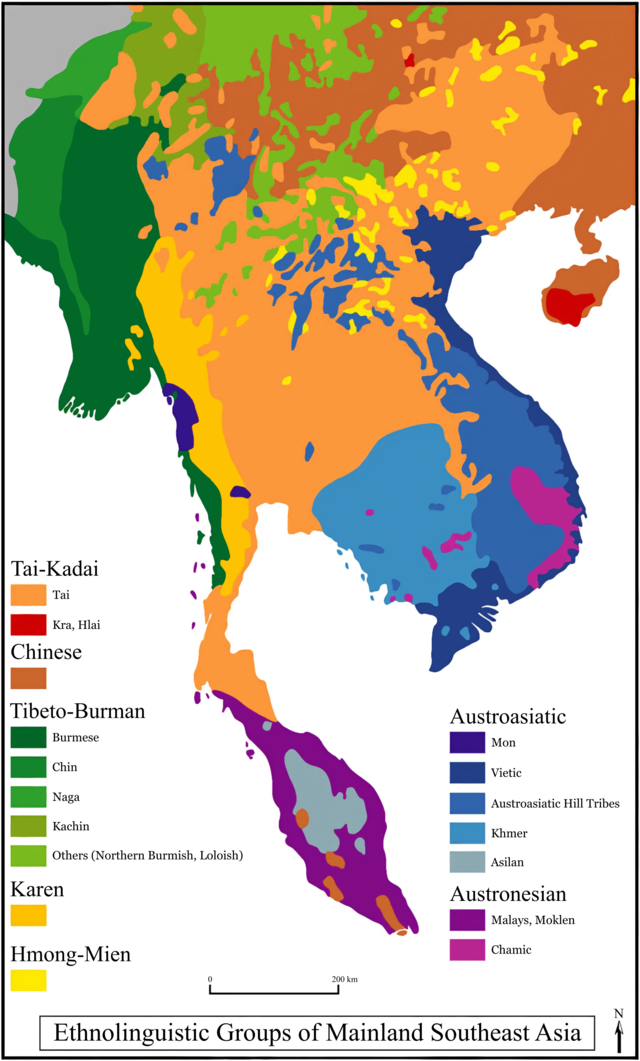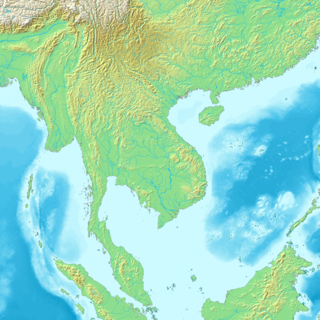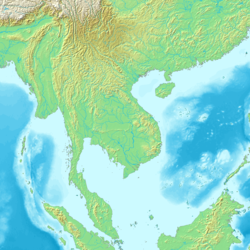Mainland Southeast Asia
Continental portion of Southeast Asia From Wikipedia, the free encyclopedia
Mainland Southeast Asia (historically known as Indochina and the Indochinese Peninsula) is the continental portion of Southeast Asia. It lies east of the Indian subcontinent and south of Mainland China and is bordered by the Indian Ocean to the west and the Pacific Ocean to the east. It includes the countries of Cambodia, Laos, Myanmar, Singapore, Thailand and Vietnam as well as Peninsular Malaysia.[1]
The term Indochina (originally Indo-China) was coined in the early nineteenth century, emphasizing the historical cultural influence of Indian and Chinese civilizations on the area. The term was later adopted as the name of the colony of French Indochina (today's Cambodia, Laos, and Vietnam). Today, the term Mainland Southeast Asia is more commonly used, in contrast to Maritime Southeast Asia for the island groups off the coast of the peninsula.
Terminology
Summarize
Perspective

In Indian sources, the earliest name connected with Southeast Asia is Yāvadvīpa.[2] Another possible early name of mainland Southeast Asia was Suvarṇabhūmi ("land of gold"),[2][3] a toponym, that appears in many ancient Indian literary sources and Buddhist texts,[4] but which, along with Suvarṇadvīpa ("island" or "peninsula of gold"),[2] are also thought to refer to insular Southeast Asia.[2]
The origins of the name Indo-China are usually attributed jointly to the Danish-French geographer Conrad Malte-Brun, who referred to the area as indo-chinois in 1804, and the Scottish linguist John Leyden, who used the term Indo-Chinese to describe the area's inhabitants and their languages in 1808.[5] Scholarly opinions at the time regarding China's and India's historical influence over the area were conflicting, and the term was itself controversial—Malte-Brun himself later argued against its use in a later edition of his Universal Geography, reasoning that it overemphasized Chinese influence, and suggested Chin-India instead.[6] Nevertheless, Indo-China had already gained traction and soon supplanted alternative terms such as Further India and the Peninsula beyond the Ganges. Later, however, as the French established the colony of French Indochina (covering present-day Cambodia, Laos, and Vietnam), use of the term became more restricted to the French colony,[7] and today the area is usually referred to as Mainland Southeast Asia.[8]
Biogeography
In biogeography, the Indochinese bioregion is a major region in the Indomalayan realm, and also a phytogeographical floristic region in the Oriental Paleotropical Kingdom. It includes the native flora and fauna of all the countries above. The adjacent Malesian Region covers the Maritime Southeast Asian countries, and straddles the Indomalayan and Australasian realms.[9]
Geography


The Indochinese Peninsula projects southward from the Asian continent proper. It contains several mountain ranges extending from the Tibetan Plateau in the north, interspersed with lowlands largely drained by three major river systems running in a north–south direction: the Irrawaddy (serving Myanmar), the Chao Phraya (in Thailand), and the Mekong (flowing through Northeastern Thailand, Laos, Cambodia and Vietnam). To the south it forms the Malay Peninsula, located on which are Southern Thailand and Peninsular Malaysia; the latter is variably considered part of Mainland Southeast Asia or separately as part of Maritime Southeast Asia.[citation needed] Most of it has a tropical climate except for subtropical places such as Northern Vietnam.[10]
Culture
Summarize
Perspective

Mainland Southeast Asia contrasts with Maritime Southeast Asia, mainly through the division of largely land-based lifestyles in Indochina and the sea-based lifestyles of the Indonesian archipelago and Philippine archipelago, as well as the dividing line between the Austroasiatic, Tai–Kadai, and Sino-Tibetan languages (spoken in Mainland Southeast Asia) and the Austronesian languages (spoken in Maritime Southeast Asia). The languages of the mainland form the Mainland Southeast Asia linguistic area: although belonging to several independent language families, they have converged over the course of history and share a number of typological similarities.[citation needed]
The countries of mainland Southeast Asia received cultural influence from both India and China to varying degrees.[11] Cambodia, Laos, Myanmar and Thailand are all influenced by Indian culture, only Vietnam is influenced by Chinese culture but still has minor influences from India, largely via the Champa civilization that Vietnam conquered during its southward expansion.[citation needed]
Overall, Mainland Southeast Asia is predominantly Buddhist[12][13][14][15][16][17] with minority Muslim and Hindu populations.[18][19]
See also
- Related regional concepts
- Sub-regions
References
Further reading
External links
Wikiwand - on
Seamless Wikipedia browsing. On steroids.

